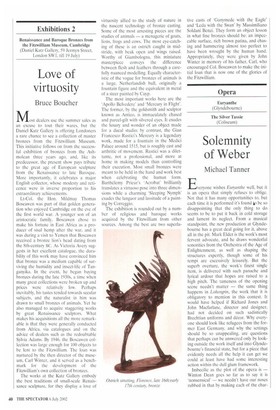Exhibitions 2
Renaissance and Baroque Bronzes from the Fitzwilliam Museum, Cambridge (Daniel Katz Gallery, 59 Jermyn Street, London SW!, till 19 July)
Love of virtuosity
Bruce Boucher
Most dealers use the summer sales as an excuse to tout their wares, but the Daniel Katz Gallery is offering Londoners a rare chance to see a collection of master bronzes from the Fitzwilliam Museum. This initiative follows on from the successful exhibition of bronzes from the Ashmolean three years ago, and, like its predecessor, the present show pays tribute to the great age of European sculpture from the Renaissance to late Baroque. More importantly, it celebrates a major English collector, whose modesty and reticence were in inverse proportion to his extraordinary achievements.
Lt-Col. the Hon. Mildmay Thomas Boscawen was part of that golden generation who enjoyed Cambridge on the eve of the first world war. A younger son of an aristocratic family, Boscawen chose to make his fortune in East Africa as a producer of sisal hemp after the war, and it was during a visit to Yemen that Boscawen received a bronze lion's head dating from the 8th-century BC. As Victoria Avery suggests in her excellent catalogue, the durability of this work may have convinced him that bronze was a medium capable of surviving the humidity and insect-life of Tanganyika. In the event, he began buying bronzes during the late 1930s, a time when many great collections were broken up and prices were relatively low. Perhaps inevitably, his tastes tended towards secular subjects, and the naturalist in him was drawn to small bronzes of animals. Yet he also managed to acquire staggering works by great Renaissance sculptors. What makes his acquisitions all the more remarkable is that they were generally conducted from Africa, via catalogues and on the advice of dealers such as the redoubtable Sylvia Adams. By 1946, the Boscawen collection was large enough for 100 objects to be lent to the Fitzwilliam. The loan was nurtured by the then director of the museum, Carl Winter, and it served as a benchmark for the development of the Fitzwilliam's own collection of bronzes.
The works at the Katz Gallery embody the best traditions of small-scale Renaissance sculpture, for they display a love of virtuosity allied to the study of nature in the nascent technology of bronze casting. Some of the most arresting pieces are the studies of animals — a menagerie of goats, lions, frogs and cows. The most eye-catching of these is an ostrich caught in midstride, with beak open and wings raised. Worthy of Giambologna, this miniature masterpiece conveys the difference between flesh and feathers through a carefully nuanced modelling. Equally characteristic of the vogue for bronzes of animals is a large, Netherlandish bull, originally a fountain figure and the equivalent in metal of a steer painted by Cuyp.
The most important works here are the 'Apollo Belvedere' and 'Mercury in Flight'. The former, by the goldsmith and sculptor known as Antico, is immaculately chased and parcel-gilt with silvered eyes. It exudes the luxury and wonder of an object made for a ducal studio; by contrast, the Gian Francesco Rustici's Mercury is a legendary work, made for a fountain in the Medici Palace around 1515, but is roughly cast and arthritic of movement. Rustici was a dilettante, not a professional, and more at home in making models than controlling their execution. Most small bronzes were meant to be held in the hand and work best when celebrating the human form. Barthelemy Prieur's 'Acrobat' brilliantly translates a virtuoso pose into three dimensions while a charming 'Sleeping Nymph' exudes the languor and lassitude of a painting by Correggio.
The exhibition is rounded out by a number of religious and baroque works acquired by the Fitzwilliam from other sources. Among the best are two superla tive casts of `Ganymede with the Eagle' and 'Leda with the Swan' by Massimiliano Soldani Benzi. They form an object lesson in what fine bronzes should be: an impeccable surface, rich brown patina, and chasing and hammering almost too perfect to have been wrought by the human hand. Appropriately, they were given by John Winter in memory of his father, Carl, who encouraged Col. Boscawen to make the initial loan that is now one of the glories of the Fitzwilliam.


























































 Previous page
Previous page